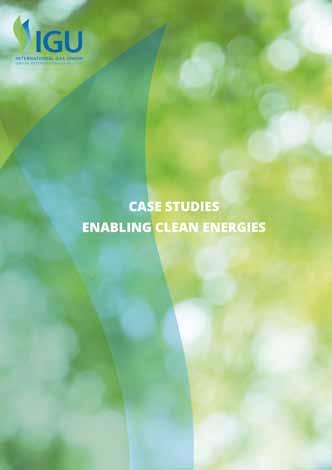
26 minute read
LNG approaching critical mass as a globalising force for natural gas
from IGU Magazine October 2016
by IGU
By Alex Forbes
Amidst all the near-term worries of supply gluts, faltering demand and weak prices, the direction of travel for LNG is becoming clearer. While the coming five to eight years will be a tough time for producers and the sponsors of new liquefaction projects, the long-term future for the industry looks promising – as LNG becomes an ever more potent force in the globalisation of regional gas markets. The very factors that are challenging in the near term are likely to be sources of opportunity in the long term: low gas prices will encourage market growth; low oil prices will accelerate moves towards new gas pricing mechanisms; new climate policies will make gas more competitive with coal. That was a clear message from the LNG 18 conference in Australia earlier this year. Another was that the industry needs to work harder to realise its full potential. “Don’t take it for granted,” cautioned one leading CEO.
The triennial LNG X conferences have long been the largest regular gatherings of the liquefied natural gas industry. Until a decade or so ago, while LNG remained a niche industry, they felt like the meetings of a select club: many of the participants knew many of the other participants, having got to know each other during negotiations for new projects and sales and purchase agreements (SPAs). The international oil and gas companies (IOGCs) and the national oil and gas companies (NOGCs) would send their LNG specialists.
LNG 12 in Perth, Australia in 1998 was just such an event. At that time, there were nine LNG-exporting nations and nine importing nations. Around 84 million tonnes of LNG were traded in that year and the shipping fleet consisted of around 108 vessels.
Last April, at LNG 18, Perth became the first city to host the event twice. In the intervening time, LNG trade trebled. According to the 2016 edition of the IGU World LNG Report – launched at LNG 18 – in 2015 LNG trade grew to 245 million tonnes. The number of producing countries was up to 17, despite Angola and Egypt having ceased exports since 2014. The number of importing countries was up to 33. The shipping fleet had grown to 410 vessels, and the average size of ships had expanded too. Regas capacity around the world had reached 757 million tonnes per annum (Mtpa), with another 73 Mtpa due on stream by 2019.
A gathering of gas leaders
Impressive as these numbers are, arguably the most telling sign at LNG 18 of how important LNG has become was that many IOGCs and NOGCs fielded not just their LNG specialists but also their CEOs.
In attendance – and mostly leading the discussions – were Shell’s Ben van Beurden, Chevron’s John Watson, ConocoPhillips’ Ryan Lance, Total’s Patrick Pouyanné, Petronas’s Datuk Wan Zulkiflee Wan Ariffin, Inpex’s Toshiaki Kitamura, Woodside’s Peter Coleman, RasGas’s Hamad Mubarak Al Muhannadi, Gazprom Export’s Alexander Medvedev and others. LNG 18 was as much a gathering of the world’s natural gas industry as it was an LNG conference.
To those who follow closely the development of the natural gas industry, this should not come as a surprise. As this magazine has previously reported (International Gas, October 2015 – March 2016, pages 78-89), the big IOGCs are steadily becoming bigger producers of natural gas than they are of oil. And LNG
trade has been growing at around three times the rate that the gas industry has been growing overall – a compound annual growth rate of 6.5% over a period of almost two decades (International Gas, April – September 2016, pages 112-123).
“Towards a globally integrated gas market”
The growing importance of LNG to the development of global gas trade dynamics was highlighted by BP’s Chief Economist Spencer Dale at the launch of the BP Statistical Review of World Energy in June. In the analysis that accompanies the 2015 data, Dale said:
“The deceleration in China’s gas consumption, combined with falls in South Korea and Japan, meant that after being the primary growth market for LNG over the past five years or so, Asia’s LNG demand fell in 2015. As a result, LNG flows were diverted west, with increased LNG imports to both Middle East and North Africa [MENA] and Europe. This shift in the pattern of trade flows went hand-in-hand with a sharp narrowing in price differentials, with the Asian premium over European gas prices virtually disappearing.
“The key takeaway here is that, as global LNG supplies grow in importance and, as a consequence, global gas trade becomes increasingly price sensitive, the impact of shocks or disturbances in one part of the world, in this case weak Asian demand, will be increasingly transmitted to other parts of the globe. We are moving towards a globally integrated gas market.”
A new growth phase
This process of globalisation looks set to accelerate as the LNG industry undergoes another phase of rapid growth. At LNG 18 several speakers forecast that LNG supply by 2020 would reach 350 Mtpa, with some even more optimistic. “We expect worldwide LNG production to increase to approximately 370 Mtpa by the year 2020,” said RasGas CEO, Hamad Mubarak Al Muhannadi.
Looking further ahead, Melody Meyer, President of Chevron Asia Pacific Exploration and Production Company, said: “By 2025 LNG demand is expected to reach 420 Mtpa, nearly double today’s market. This rising demand will be driven by global economic growth, and the rising share of gas as part of that growth …
c The opening plenary
session moderated by Maria van der Hoeven, Clingendael Institute, featured, from left to right, John Watson, CEO and Chairman of the Board, Chevron; Ben van Beurden, CEO, Shell; and Peter Coleman, CEO and Managing Director, Woodside.
z Melody Meyer,
President of Chevron Asia Pacific Exploration and Production Company: by 2025 LNG demand is expected to … nearly double today’s market.
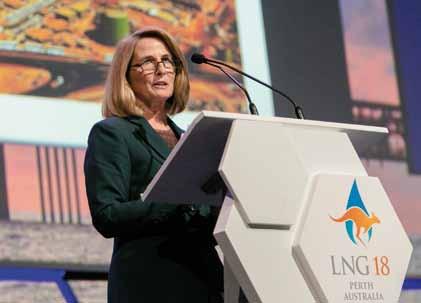
The biggest change we’ll see will be the proliferation of smaller and smaller markets – 0.5-1 Mtpa markets – where demand can be met very quickly with floating storage and regasification units [FSRUs].”
Meg Gentle, President of Marketing at Cheniere Energy, added: “The expected call on LNG by 2030 requires nearly 230 Mtpa of new liquefaction capacity to be starting construction by 2025. That is at least 45 new trains that need to reach final investment decision [FID].”
A looming gas glut
The International Energy Agency (IEA), in its latest Medium-Term Gas Market Report (MTGMR), forecasts that LNG demand will increase by 140 billion cubic metres (bcm)/year (103 Mtpa) between 2015 and 2021, while new liquefaction capacity will grow by 190 bcm/year (140 Mtpa). It therefore sees “a high likelihood of under-utilisation of LNG export plants”.
Most of the new liquefaction capacity due on stream by 2020 is in Australia and the United States.
In Australia, from 2009 onwards, seven LNG supply projects reached FID, with total capacity of 62 Mtpa. The first project started up in late 2014 and all are due on stream by 2018. Once fully operational, they will take Australia’s liquefaction capacity to 87 Mtpa.
In the US, five projects have taken FID and begun construction, with aggregate capacity of 66 Mtpa. Of this total, 32 Mtpa is being constructed by Cheniere, which has started up two trains at the first liquefaction project in the Lower 48 states: Sabine Pass. All the trains are due to start up by 2019.
So, by the end of the decade, Australia and the US will have combined production capacity of 152 Mtpa, of which 128 Mtpa will be new. A few other projects should also be on stream by then, among them Russia’s Yamal LNG.
When all this new capacity was being planned, demand was expected to grow fast enough to absorb its output, or at least most of it. However, some buyers, finding they are overcontracted, are looking to sell on volumes – or liquefaction capacity in the case of projects using a tolling business model – in an emerging secondary market.
At LNG 18, Grant King – Chairman of the LNG 18 National Organising Committee – said: “The liquidity in the secondary market will accelerate and will deepen, because buyers will be using the destination flexibility that they have under the contracts. That will result in a more liquid secondary market. That’s where you’ll see price movement, more than in the contract market, because the contract market is what it is. That secondary market will drive growth in demand.”
Other buyers, meanwhile, have been seeking early price reviews for their long-term contracts. An example that got a lot of attention at LNG 18 is India’s Petronet, which has renegotiated an SPA with Qatar’s RasGas, obtaining a lower price in return for taking higher volumes.
Market uncertainties
In Japan, the world’s largest LNG market, LNG imports in 2015 were down 3.1 Mt on 2014, following the first re-start of nuclear reactors since 2013, weaker electricity demand, and
v Yuji Kakimi, President
of Fuel Procurement, JERA, outlined his company’s response to Japanese energy market liberalisation.
v CNOOC Vice President,
Li Hui, told delegates of the opportunities offered by China as an emerging market.

inter-fuel competition. Looking forward, the nation’s energy companies face big uncertainties, one of which is over the pace of re-starts of its fleet of nuclear power stations.
At LNG 18, Professor Jonathan Stern of the Oxford Institute of Energy Studies (OIES) said: “The problem for those of us who visit Japan regularly is that every time we go back we find
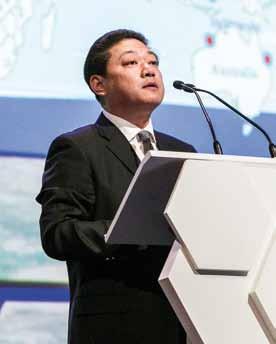
that the immediate prospects for the re-opening of nuclear stations are less optimistic than when we were last there … A lot more LNG may have to be imported to compensate for those stations that may be slower to open than is currently anticipated.”
Another uncertainty is the market liberalisation taking place in gas and electricity. Masayuki Tanimoto – Director-General of the Oil and Gas Finance Department of the Japan Bank for International Co-operation (JBIC) – told the conference:
“Japan has liberalised the electricity market and next year we will have the liberalisation of the gas market. We are transitioning from a centrally-planned economy to a real market economy, so it’s getting more difficult for Japanese utilities to make a long-term commitment, like 20 years, because they cannot be sure how big a share of the market they can get after competition.”
The response to these developments by JERA – the joint venture established by Chubu Electric and Tokyo Electric (TEPCO), now the world’s largest LNG buyer – was outlined by its President of Fuel Procurement, Yuji Kakimi:
“We are going to diversify contract maturities in our portfolio. Second, we are going to buy less LNG employing an oil-linked pricing formula. Third, we are going to build a robust trading function, both on the buy and sell sides, to adapt to large swings in demand for LNG and to optimise our purchases. Fourth, we will be engaged proactively in the development of LNG projects.”
There is also uncertainty over how quickly LNG demand will grow in China, already the world’s third-largest LNG market. While demand growth has slowed, government policy is to boost the share of gas in the primary energy mix from around 6% today to 10% by 2020.
Li Hui, Vice-President at CNOOC – one of China’s big three state-owned oil and gas companies – told delegates: “As an emerging market, China offers great opportunities for the
gas industry. In 2015 China consumed 193 bcm, increasing by 5.7% year-on-year. According to the official forecast, by 2020 the share of natural gas consumption will rise to 10%, which represents 300-360 bcm/year.”
However, China’s gas market is still immature. “Gas infrastructure needs to be improved, especially the storage and peakshaving facilities,” said Li, adding that “Chinese buyers are facing great challenges in the execution of existing long-term LNG supply contracts”.
What about Europe?
The prospect of large volumes of uncommitted LNG looking for a home in an oversupplied market raises the question of where it will all go. There is a growing consensus that much of it will be targeted at Europe. This issue was the focus of an OIES report published early this year which was reported on in some detail in the previous issue of this magazine (International Gas, April – September 2016, pages 112-123). It is a view that has since gained currency, both at LNG 18 and in developments since.
At the launch of its MTGMR in June, the IEA said: “Fundamental developments point to oversupply in the market over the forecast horizon of this report [2016-2021] which should keep spot gas prices across the globe under pressure: ‘unwanted’ LNG supplies will look for a home in Europe, due to the flexibility of its gas system and well-developed spot markets.”
This will result in intense competition developing among producers “to retain or gain access to European customers”. “We are at the start of a new chapter in European gas markets,” said the agency’s Executive Director Fatih Birol.
At LNG 18, an analysis of how this development might pan out was presented by Benjamin Maruenda, Chief Strategy Officer for the LNG business of Engie, the largest importer of LNG into Europe.
“As we understand that most of the additional LNG to Europe would come from the US,” said Maruenda, “at what Henry Hub and NBP levels would this happen? There are three scenarios.
“If NBP is high, above $7/million British thermal units (MBtu), with Henry Hub at $2/MBtu, US LNG will enter into Europe without any restriction. If NBP is at a medium level, we think that in such a scenario US LNG would also come into Europe as the players would consider fixed costs as sunk and [make decisions] on a marginal cost basis. If NBP is low, US LNG will not be exported into Europe and some liquefaction plants would be shut in. However, in that scenario there would be a switch from coal to gas which eventually would increase the demand for gas in Europe.”
The single most important factor in the evolution of European prices will be Russia’s gas export strategy. If Gazprom chooses to defend price, LNG imports into Europe will rise very substantially, reducing the share of Gazprom’s pipeline gas exports to Europe. If Gazprom chooses to defend market share, however, prices could fall to levels that would make US LNG exports to Europe uneconomic.
One of the speakers at LNG 18 was Alexander Medvedev, Deputy Chairman of Gazprom’s Management Committee, and the longtime Head of Gazprom Export. But he gave no clues as to which option Russia might adopt. So we have yet to see what the world’s largest gas company will choose to do.
Opportunities
While there was a sense of resignation at LNG 18 that the period from now to around 2023 will be a challenging time for the natural gas industry in general and the LNG industry in particular, the mood of the conference was far from being one of doom and gloom.
Time and again, industry leaders expressed their confidence about LNG’s bright prospects over the long term – a time span measured in decades rather than years – because the very factors that are currently challenging the industry are potentially sources of opportunity.

Global receiving terminal capacity 2000-2021
Million tonnes per annum 900
800
700
600
500
400 90%
80%
70%
60%
50%
40%
300
200 30%
20%
100 10%
0
2000 2001 2002
Existing 2003 2004 2005 2006 2007 2008 2009
Under construction in 2016 2010 2011 2012 2013 2014 2015
Utilisation (right axis) 2016 2017 2018 2019 2020 2021 0%
Note: The above forecast only includes projects sanctioned as of end-2015. Owing to short construction timelines for regasification terminals, additional projects that have not yet been sanctioned may still come online in the forecast period, as indicated by the hatched bars. Although several FSRU contracts will expire over this time period, this forecast assumes that the capacity will remain in the global market. Sources: IHS, Public announcements. c Hamad Mubarak Al
Muhannadi, RasGas CEO: the next five years are going to be tough [but] our perspective on the long term remains very optimistic.
c Figure 1.
Samsung Engineering – 40 years of excellence as a reliable EPC partner for the gas industry
Commitment to innovation and opportunity
Founded in 1970, Samsung Engineering has grown from a modest, domestic engineering firm to a globally recognised name in the engineering, procurement and construction (EPC) market. Attracting talent from around the world, Samsung Engineering has broadened its business portfolio to a full range of engineering services: oil and gas processing, refinery and petrochemical plants; power plants; environmental facilities; and industrial production facilities. Samsung Engineering had an especially strong presence with gas projects starting with its first international project in 1993, winning PTT Public Company Ltd.’s gas separation plant (GSP-4) in Thailand and has continued by offering an everexpanding list of engineering services.
By pairing innovative, cost-effective engineering with flexible, efficient management, Samsung Engineering is able to provide significant, dependable value to our clients. Looking towards the future, Samsung Engineering is primed to contribute to both emerging and established global industries.
Samsung Engineering at a glance
Samsung Engineering is an EPC leader in hydrocarbon, power and industrial & environmental plants, providing services from feasibility studies, financing, engineering, procurement, construction to O&M. About 1,000 projects have been built worldwide by Samsung, bearing witness to global competitiveness, particularly in quality, cost and delivery.
Samsung Engineering is expanding its business presence globally in step with international market trends, diversifying and stabilising its business portfolio. Hydrocarbon Oil and Gas Processing, Refinery, Petrochemical Power Coal-fired, Oil-fired, Gas-fired (Simple Cycle, Combined Cycle), IGCC (Integrated Gasification Combined Cycle), CHP (Combined Heat and Power Plant)
Industrial & Environmental
IT, Pharmaceutical (Bio), Manufacturing, Sewage Treatment, Wastewater Treatment, Water Treatment, Water Reuse, Desalination, Ultra-pure Water, Air Pollution Prevention, Waste Treatment
We build the word through gas projects – Samsung Engineering your growth partner for the future
Samsung Engineering has completed numerous gas-related projects including six gas oil separation plant (GOSP) EPC and 11 gas separation plant (GSP) EPC projects as well as three liquefied natural gas (LNG) liquefaction feasibility study/ front end engineering design (FS/FEED) and one LNG Terminal EPC project, making a total of more than 30 gas projects worldwide.
Recently, Samsung Engineering’s strategic focus lies in LNG liquefaction projects, where major investments have been made. Several feasibility studies for medium-sized LNG liquefaction projects have been realised and FEED projects in America have been made. For large-sized LNG liquefaction projects Samsung Engineering relies on strategic partnerships with proven and experienced global LNG EPC players. In further enhancing capabilities for LNG projects, Samsung Engineering made the effort to secure LNG experts from all over the world as well as use repeated experience from proven major technology licensors such as Air Products and Chemicals, Inc. (APCI).
Besides LNG projects, GOSP/GSP are major focuses for Samsung Engineering. Abundant experiences in the last five years provide optimised solutions for GOSP/GSP project execution. Samsung Engineering’s efficient project management capacities led to the successful project execution of large-sized projects, bringing confidence and trust to clients. This is especially shown by repeated contract orders Samsung Engineering is receiving from loyal clients such as PTT from Thailand.
Representative LNG/GOSP/GSP project experiences include: for LNG liquefaction – the Texas LNG project with LNG liquefaction of 2.1 Mtpa, APCI (liquefaction), UOP (pre-treatment) as licensor; for LNG terminals – the CFE Manzanillo LNG terminal with LNG receiving capacity of 14 Mm³/d and two 150,000m³ LNG tanks; for GOSP, gas treatment/NGL recovery – the Shaybah Project with 113.3 Mm³/d of gas separation and 68 Mm³/d of gas treatment/ NGL recovery; and for GSP – the GSP-6 and ESP projects, which combined pro
Process experience
l l l l l GOSP (gas oil separation plant) GSP (gas separation plant) ASU (air separation unit) LNG liquefaction LNG regasification
Technology experience
l l l l l l l l APCI Shell UOP BASF Ortloff Jacobs Mitsubishi Heavy Industry Haldor Topsoe
cessed 45.3 Mm³/d of gas (22.65Mm³/d each) and was the world’s largest plant of this kind at that time.
Samsung Engineering capabilities for gas project execution include the following: Remote area execution Saudi Arabia, Iraq, Algeria, Indonesia, Malaysia, Thailand, etc.
Simultaneous project execution
Two in Thailand (GSP-6 and ESP); multipackage complex across five separate job sites (Shaybah NGL Program).
Mega-size GOSP/GSP project
execution Saudi Arabia Shaybah NGL Program (Over $2 billion); Iraq West Qurna Phase-2 (Over $1 billion); Thailand GSP-6 and ESP (Over $1 billion).
All-round technology
execution UOP, Ortloff, Shell, BASF, ABB, APCI and more.
Utmost efficient and real-time
completion execution Zenator, SCMS, CM Tool, Plentiful Lessons Learned and Best Practice.
Project focus: Thailand
PTT Public Company Ltd. operates four gas separation plants, GSP-1, GSP-2 and GSP-3 and GSP-5, with a total capacity of 41.9 Mm³/d at its Map Ta Phut gas separation complex in Rayong, Thailand. The Map Ta Phut plants recover ethane and propane as feedstock for petrochemical plants located in the area and LPG as fuel to be utilised by the transport sector. The remaining gas is used for the production of electricity and fuel for the transport industry. To cope with the rising demand for these products and to maximise the use of indigenous natural gas, in September 2007 PTT awarded Samsung Engineering the GSP-6 gas separation plant and ESP ethane separation plant project.
Gas Separation Plant #6 (GSP-6)
commissioning project was delivered on a lump-sum, turn-key basis, and achieved project completion in January 2011 for GSP-6 and February 2011 for ESP.
With GSP-6 now successfully completed, the plant has a capacity of 22.65Mm³/d, recovering ethane, propane, butane, liquefied petroleum gases and natural gas liquids from natural gas. The ESP also has a capacity of 22.65Mm³/d, separating gas as well as ethane. The products are supplied to downstream petrochemical plants and supplement the local market for domestic consumption while residual gas is sent to the natural gas distribution network.
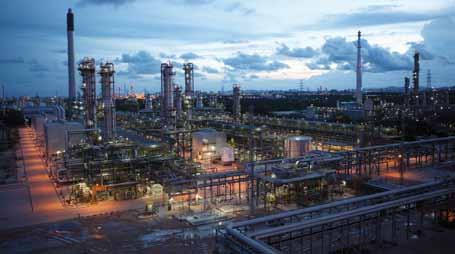
Both projects were safely completed. By close of construction about 20,000,000 man- hours were achieved for GSP-6 and 15,000,000 for ESP. Further, the projects were completed on-time and on budget. Scale-wise it was the largest gas separation plant in the world at the time in terms of production numbers through fractionation units such as C2, C3, C4, NGL, iso-pentane with feed throughput of 68 Mm³/d simultaneously in the ESP and GSP-6 Plant.
Samsung Engineering received a distinguished project award in 2011 for the GSP-6 project from PMI (Project Management Institute) for its project management capabilities.

v Figure 2.
v Figure 3.
Energy price development 2008-2016
$/MBtu
25
20 By 2010, US shale began to decouple US prices from Asia and Europe Japan’s demand growth increased Asian prices in 2011, but thereafter US LNG softened prices
15
10
5 Term prices converging with hubs due to US LNG, oil price collapse, and weak demand
0 2008 2009 2010 2011 2012 2013 2014 2015 2016
Japan Average LNG Import Price JKM DES Spot Price NBP HH
Source: Berkeley Research Group. Data: Japan Average LNG import price, NBP and HH prices sourced from Bloomberg. JKM DES spot prices sourced from Platts.
“The next five years are going to be tough, but as an industry we’re going to have to be resilient,” said RasGas CEO, Hamad Mubarak Al Muhannadi. “The current environment is an opportunity for us. It is an opportunity for demand to grow. Low-cost LNG will encourage new customers to come, and to develop more infrastructure. So we’re focusing on going into new markets. Our perspective on the long term remains very optimistic.”
LNG trade by contract length
There was much discussion at LNG 18 of the impact that a prolonged period of low prices could have on the expansion of existing LNG markets and the development of new ones – in new territories and in new applications, such as road transport and marine bunkering. Figure 1, previous page from the latest IGU LNG report, shows a forecast of the growth of regasification capacity based on projects sanctioned as of
end-2015. However, the report stresses that
mtpa
300
250
200
150 28%
100
50
0 2000 2001 2002 2003 2004 2005 2006 2007 2008
Short-term trade Mid- & long-term contract trade 72%
2009 2010 2011 2012 2013 2014 2015
Source: GIIGNL (2000-2015 actual). Cheniere Energy (2020 projection). 50%
50%
2020
short construction times, especially for floating regas, could see more projects come online during the forecast period. Current low levels of capacity utilisation also present opportunities for market growth.
Gas prices
At LNG 18 several speakers said that the 2011- 2014 period of $100-plus/barrel oil prices should be regarded as anomalous. Analysing the development of energy prices from 2008 to 2016, Christopher Goncalves of the Berkeley Research Group identified three broad phases: pre-2011; 2011 to 2014; and post-2014 (see Figure 2).
“In hindsight perhaps the industry will look at what happened from 2011 to 2014 – after the Great Japan Earthquake and the Fukushima [nuclear] tragedy – as a period of anomaly,” he said. “Global prices are re-converging, oil-indexed prices are re-converging with hub prices, and regional prices in Asia, Europe and the Americas are all pulling closer together, as a function of greater liquidity and weaker demand.”
Cheniere Energy – which by 2020 will be the dominant owner of natural gas liquefaction capacity in the United States and one of the largest owners of liquefaction capacity in the world – sees the share of spot and short-term LNG trade (defined by importers’ group GIIGNL as contracts with a duration of four years or less) growing to 50% of the total by 2020 (see Figure 3). Such an outcome would represent a rapid acceleration of what has been a longterm trend, leading to a huge increase in

Leading owner and operator of floating LNG import infrastructure
v Prof. Jonathan Stern of
the Oxford Institute of Energy Economics: it is no longer possible to price LNG, or indeed gas, in relation to oil products.
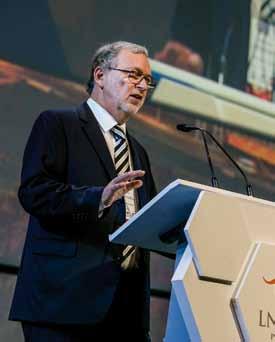
liquidity in an industry still dominated by longterm contracts.
While the 2011-2014 period may have been anomalous, for many it didn’t feel like it at the time. So it damaged the prospects for gas in key markets, especially in Asia, where most LNG is priced on the basis of indexation to oil prices. The perception that LNG was likely to remain a high-priced commodity meant that a lot of investment that could have gone into gas instead went into coal, especially in electricity generation.
The lower prices resulting from the oil price collapse and the LNG supply glut are already changing investment attitudes. The IEA’s MTGMR highlights the case of India, where until recently utilisation of the nation’s fleet of gas-fired power stations has been low because imported LNG was seen as too expensive:
“In India, gas demand is set to grow robustly, at an annual average rate of almost 6% over the forecast period of this report [2016-2021]. The increase marks an important turning point for the country’s gas sector, which suffered demand declines in recent years amid falling domestic production and very high LNG import prices. The recent sharp fall in international benchmarks in conjunction with significant revisions to domestic pricing policies and continued gradual progress in building out gas infrastructure should help drive demand growth in this highly price-sensitive market.”
But it is critical that affordability is seen as sustainable if gas is to compete with coal and renewables over the long term. As several speakers at LNG 18 stressed, effective carbon pricing is one major potential contributor to this.
Moving away from oil indexation
Other potential contributors include: reductions in project costs; and a move away from oil indexation in gas contracts to free gas from the vagaries of the irrelevant and damaging volatility of oil prices. Buyers and sellers are now looking for more meaningful pricing mechanisms that reflect the supply and demand fundamentals of gas rather than oil.
Commenting on the evolution of gas pricing mechanisms in Asia, Jonathan Stern said: “It is no longer possible to price LNG, or indeed gas, in relation to oil products … These contracts have got to find a way – as we have tried in Europe, with some difficulty – to move to a supply-demand basis for gas rather than oil.”
Even Asian buyers – currently benefitting from long-term contracts indexed to low oil prices – are saying they want less exposure to oil price. “To develop our customer base more and more, we need more and more marketbased pricing – not oil-linked pricing,” said Kunio Nohata, Senior Executive Officer of Tokyo Gas.
However, while there exists a growing consensus that oil indexation is not the optimal way to price natural gas, the debate around alternatives is a lively one. At LNG 18 there was much discussion about how LNG into Asia could be priced in a post-oil-indexation gas price world. For example, will a hub or hubs emerge in Singapore, Japan and/or China?
“My observation is that for the time being we have no perfect price formula to replace JCC,” said INPEX CEO, Toshiaka Kitamura. That said, the consensus at the conference was that change is now only a matter of time.
Welcoming the Paris Agreement on climate
Natural gas industry leaders have been very vocal about their desire for a strong international agreement on climate change, and at LNG 18 they celebrated the historic success of the COP 21 talks last December.
“The treaty signed by 195 countries in Paris is a fact,” said Total’s CEO, Patrick Pouyanné. “And for the energy world it should be considered not as a constraint but as an opportunity.”
Like other gas industry leaders, Pouyanné regards carbon pricing as essential to improving the competitiveness of natural gas over its great rival in electricity generation: coal.
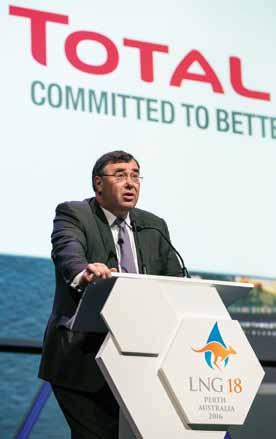
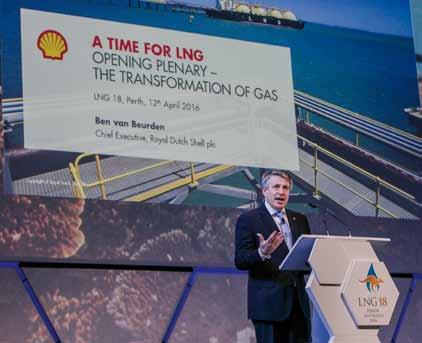
Highlighting the switch that has been taking place from gas to coal in the electricity fuel mix of a number of countries in both Asia and Europe, Pouyanné said: “This is why I believe a carbon pricing mechanism is important. It will take time. It should be progressive. But what I have learned is that the best way to make ecological progress is to give the right economic signals to investors. We will take that pricing on board and we will invest accordingly.”
“The future for our industry is bright,” said Shell CEO Ben van Beurden. “The fundamentals are very strong – driven by things like the Paris Agreement, and the inexorable growth of population and of the demand for energy to improve livelihoods and lifestyles. But we cannot sit here and take it for granted. The future will not come to us; we have to make that future … We need to be out there much more as an industry – much more assertive, much more sure-footed.”
Alex Forbes is an independent energy journalist and consultant who has been reporting on energy developments and analysing trends for three decades.
z Ben van Beurden,
CEO, Shell: the future for our industry is bright.
c Patrick Pouyanné,



